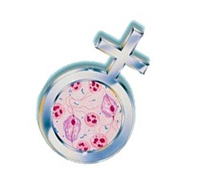Chlamydial urinary infection is an infectious disease caused by certain types of chlamydia trachomatis transmitted by sexually and affecting predominantly urinary human system. Manifestations of chlamydia, as a rule, are very scarce.
Content
Chlamydia – This is an infectious disease, developing after the introduction of a specific pathogen in the body – Chlamydia. Chlamydial urinary infection – This infectious disease caused by certain chlamydia trachomatis serotypes transmitted by sexual path and amazing predominantly urinary human system. Infection comes from people who are carriers of chlamydia or patients, with erased signs of the disease. Basic «Storage» chlamydia in the body of a woman – This is the cervical channel. The most common chlamydia among men and women leading active sex life having a messy sexual connection. Very often, the infection of chlamydia accompanies other sexually transmission infections, such as trichomonosis and gonoron. At the same time, the manifestations of these infections appear to the fore, masking the symptoms of chlamydiosis.
Manifestations of chlamydia
The incubation period of the disease ranges from 5 to 30 days. Throughout this period, the reproduction and accumulation of chlamydia in the mucous membranes. Lovers of the habitat of the pathogen in the genitals of a woman – This is a urethra (urethra), cervical channel (cervical canal) and mucosa cervical cervix. Manifestations of chlamydia, as a rule, are very scarce. Very rarely, the disease begins acutely and is manifested by the occurrence of itching, burning in the field of external genital organs, diseases of urination, mucous-purulent discharge from the vagina and stupid pulling pain at the bottom of the abdomen. More often, chlamydia has a hidden, non-rigid flow. Woman worried only insignificant itching and burning during urination, sometimes it marks a small amount of dull mucousness. Finally, anxiety may be absent at all.
 Externally, the inflammation of the urethra is manifested by redness of the mucosa around the outer opening of the urethra. The mucous membrane of the vagina is more often involved in the inflammatory process. The cervical channel is inflamed, its mucous becomes edema, red. The lesion applies to the cervix itself and the cervicitis develops. As a result of a long-lasting chlamydial inflammation, true erosion of the cervix appears. The neck of the uterus because of the rearrangements of fabrics caused by inflammation increases in the amount. After some time, the erosion of an inflammatory character is replaced by pseudo-erosion, that is, the process, when changes on the cervix already reflect the restructuring in its structure.
Externally, the inflammation of the urethra is manifested by redness of the mucosa around the outer opening of the urethra. The mucous membrane of the vagina is more often involved in the inflammatory process. The cervical channel is inflamed, its mucous becomes edema, red. The lesion applies to the cervix itself and the cervicitis develops. As a result of a long-lasting chlamydial inflammation, true erosion of the cervix appears. The neck of the uterus because of the rearrangements of fabrics caused by inflammation increases in the amount. After some time, the erosion of an inflammatory character is replaced by pseudo-erosion, that is, the process, when changes on the cervix already reflect the restructuring in its structure.
With a long existence of infection and weak protective forces of the body of a woman, chlamydial infection can affect the mucous membrane of the uterine cavity. This is facilitated by intrauterine interventions, long-term use of a spiral, the overall weakening of the body as a result of other diseases. As a result, endometrite develops, differing from non-specific nature endometritis only by the spray and non-expression of manifestations. Woman worried: general ailment, minor pulling pains in the lower abdomen, shortening the menstrual cycle, separating seals from sex tract between monthly, abundance and painfulness of menstruation.
If the inflammation is captured by the uterine pipes, then disorders in the work of the uterine pipe are added to the manifestations caused by inflammation of the endometrium. Chlamydial salpingitis, inflammation of uterine pipes, rarely leads to a complete loss of their passability. Infertility in chlamydiasis is more often a consequence of violations of their contractility, that is, the ability to push the egg to the uterine cavity. With that are connected and often cases of ectopic pregnancy in women, patients with chlamydia. In addition, inflammation of the mucous membrane of the uterus prevents the normal attachment of the fertilized egg to the endometry, that is, directly interfere with the development of pregnancy. In case the pregnancy still arises, there is a real threat to its interruption in the early days due to the inferiority of the endometrium. Changes in the cervical mucus arising from the inflammation of the cervical channel make it difficult to penetrate the spermatozoa in the uterine cavity and, therefore, prevent fertilization.
In addition to inflammation of the genital organs, chlamydia is able to cause a number of lesions of other organs. In particular, we will focus on the most common diseases – This is chlamydial conjunctivitis and Reiter's disease.
Chlamydial conjunctivitis is interesting because it is sometimes the only manifestation of chlamydia at all. Most often, the introduction of infection from the genital organs into the eyes is carried out by contact path, that is, with the help of dirty hands or when oral sex. Eye defeat is usually one-sided. Chlamydial conjunctivitis is manifested by edema, redness of the mucous membrane (conjunctivations), the appearance of mucous-purulent discharge from the eye, especially noticeable in the morning. The flow of conjunctivitis is long, within 2-3 months. It is such a long-term course of the diseases should push the idea of the presence of chlamydial infection in the body.
Reuters' disease – Another consequence of the development of chlamydial infection in the authorities of the incomplete sphere. For the disease, a triad of manifestations is characterized: urethritis (inflammation of the mucous membrane of the urethra), conjunctivitis (inflammation of the mucous membrane of the eye), and arthritis (joint inflammation). Ureteritis is manifested by itching, burning and pain when urination. Conjunctivitis – Edema, redness, reveal, purulent discharge from the eye. Arthritis affects predominantly large foot joints, such as knee and ankle and manifests the joint by swelling, pain when driving. The course of the disease is long-term, with periods of exacerbation and peace.
Diagnosis of chlamydiosis
During the examination of a woman with suspicion of chlamydia often make strokes separated from the vagina, cervix and the outer opening of the urethra with their subsequent study in the microbiological laboratory. In addition, the material for analysis on chlamydia may be scraping from cervix and urethra. But this method only assumes the presence of chlamydial infection.
Cultural method can also be used to diagnose chlamydia, when biological materials taken are seized on a special environment for the subsequent definition of the type of grown microorganism and its sensitivity to antibiotics. In addition, studies of biological fluids using the IFA method (immunoassimensional analysis), which allows the presence of antibodies to chlamydia, and the PCR method (polymerase chain reaction), which allows to detect the presence of chlamydium genome.
Treatment of chlamydiosis
Chlamydia therapy involves the treatment of a woman and her sexual partner. Treatment of women long and complicated and held in women's consultation. Mandatory condition for the success of treatment is penis. Combinations of special antihelamic drugs are prescribed. After the end of the course of treatment, a re-study is carried out for the presence of chlamydia. If the pathogen is not detected – Woman is considered cured. In case of detection of the pathogen, the treatment continues.









